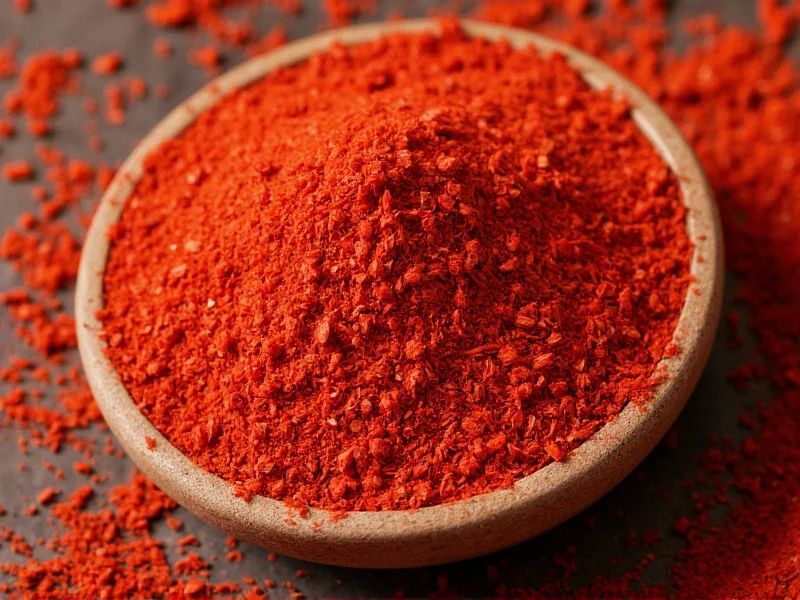When you sprinkle crushed red pepper onto your pizza or pasta, you're adding more than just color—you're introducing a distinct heat that enhances flavor profiles. Understanding exactly how spicy crushed red pepper is helps home cooks and food enthusiasts use it appropriately in their recipes without overwhelming their dishes.
What Exactly Is Crushed Red Pepper?
Crushed red pepper refers to dried and crushed chili peppers, typically made from a blend of cayenne, serrano, and other red chili varieties. Unlike single-origin spices, commercial crushed red pepper often combines multiple pepper types to create a balanced heat profile. The crushing process exposes more surface area, releasing volatile oils that contribute to both flavor and spiciness.
The Science Behind the Heat
The spiciness in crushed red pepper comes from capsaicinoids, primarily capsaicin. These compounds trigger TRPV1 receptors in your mouth and throat, creating the sensation of heat. The Scoville scale measures this heat by determining how much sugar-water solution is needed to neutralize the burning sensation.
| Pepper Type | Scoville Heat Units | Relative Heat Level |
|---|---|---|
| Crushed Red Pepper (blend) | 30,000-50,000 SHU | Moderately Hot |
| Cayenne Pepper | 30,000-50,000 SHU | Moderately Hot |
| Red Pepper Flakes | 15,000-25,000 SHU | Mild to Medium |
| Jalapeño | 2,500-8,000 SHU | Mild |
| Habanero | 100,000-350,000 SHU | Very Hot |
Crushed Red Pepper vs. Similar Products
Many people confuse crushed red pepper with red pepper flakes, but they're not identical. While both come from dried red chilies, crushed red pepper is typically spicier than standard red pepper flakes because it often contains higher-heat varieties like cayenne. Red pepper flakes usually include seeds and membranes which add heat, while some crushed red pepper blends may remove these components for a milder profile.
When comparing is crushed red pepper spicy compared to cayenne, the answer depends on the specific blend. Pure cayenne powder generally has a more consistent heat level (30,000-50,000 SHU), while crushed red pepper can vary based on the pepper mix. Some commercial blends actually contain cayenne as a primary ingredient, making their heat profiles quite similar.
Factors That Affect Crushed Red Pepper's Heat Level
Several elements influence how spicy your crushed red pepper will be:
- Pepper variety - Different chili types have varying capsaicin concentrations
- Processing method - Whether seeds and membranes are included (they contain most capsaicin)
- Age of product - Heat diminishes over time as capsaicin degrades
- Brand differences - Manufacturers create unique blends with different heat profiles
When shopping, check the label for specific pepper varieties used. Some premium blends list the exact chili types, giving you better insight into the expected heat level. This addresses the common question about how hot is crushed red pepper on Scoville scale for specific products.
Practical Cooking Applications
Understanding crushed red pepper heat level for cooking helps you use it effectively. Unlike fresh chilies where you can control heat by removing seeds, crushed red pepper's intensity is predetermined. Start with small amounts (1/8 to 1/4 teaspoon) and taste as you go—remember that heat builds over time and becomes more pronounced as dishes cook.
For those sensitive to spice, consider these techniques:
- Add crushed red pepper early in cooking for milder heat (capsaicin breaks down with heat)
- Use as a finishing spice for more pronounced heat
- Balance with dairy, acid, or sweetness to counter excessive spiciness
Storage Tips to Maintain Quality
To preserve both flavor and heat intensity, store crushed red pepper in an airtight container away from light and heat. Properly stored, it maintains peak spiciness for 1-2 years. Over time, the volatile oils that contribute to both flavor and heat dissipate, resulting in a milder product. This explains why older containers might not deliver the expected kick when you ask is crushed red pepper the same as red pepper flakes in terms of heat.
Health Considerations
The capsaicin in crushed red pepper offers potential health benefits including improved circulation and metabolism. However, those with sensitive digestive systems should use it cautiously. The burning sensation isn't actual tissue damage but rather a neurological response—your body thinks it's being burned, triggering endorphin release that creates that pleasurable "heat high" many spice lovers seek.











 浙公网安备
33010002000092号
浙公网安备
33010002000092号 浙B2-20120091-4
浙B2-20120091-4